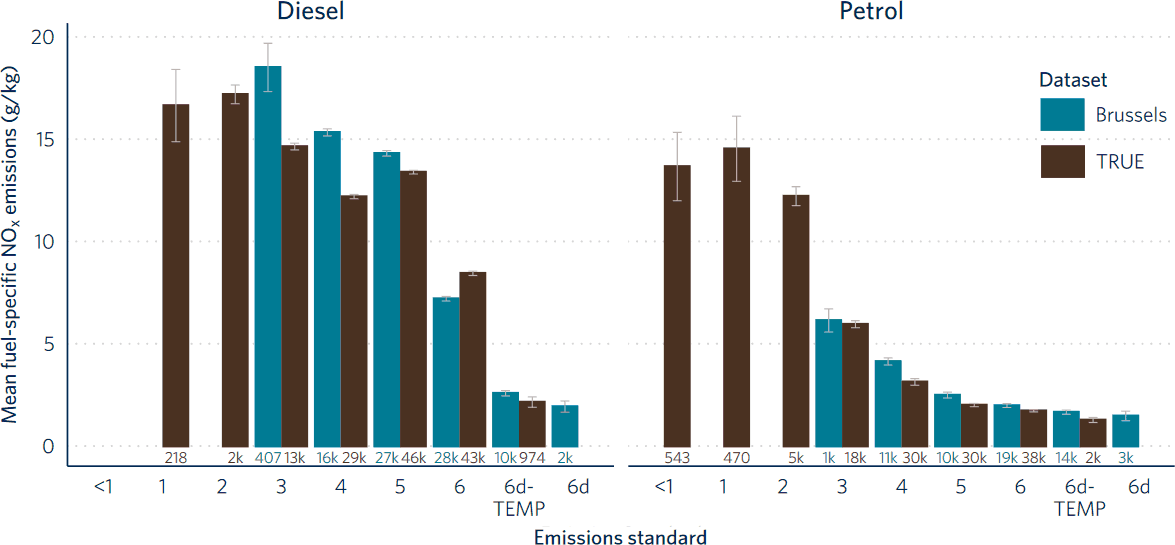ICCT: Evaluation of real-world vehicle emissions in Brussels
22 November 2021
The International Council on Clean Transportation (ICCT) released a report on the results of a vehicle emission testing study conducted by the Real Urban Emissions (TRUE) Initiative in Brussels in the fall of 2020. The study involved more than 260,000 in-use emission measurements of 130,588 unique vehicles using remote sensing technology. The data collected was analyzed with the dual goals of identifying the real-world effectiveness of key policies and regulations impacting the Brussels fleet and providing recommendations for their future development—including the low emission zone (LEZ) implemented in the Brussels-Capital Region, and the introduction of new stages of European emission standards for new vehicles.
During the study, Opus AccuScanTM RSD 5000 IR/UV spectrometers were used to measure NOx and other emissions in the exhaust plume of passing vehicles. Using the TRUE/ICCT methodology, the emission values were converted to grams NOx per kg of fuel, and then recalculated to g/km. Researchers also used a portable instrument to measure the tailpipe particle number (PN) emissions of close to 600 light-duty vehicles.
The real-world NOx emissions from diesel passenger cars operating in Brussels—particularly for diesels, but also for petrol cars—exceed the NEDC/WLTC regulatory limits for vehicle groups not subject to RDE type-approval requirements. These groups include vehicles certified to Euro 4, 5, and 6 (pre-RDE) standards. Pre-RDE diesels were found to have real-world NOx emissions 3, 4, and 5 times the respective laboratory type-approval limits. Similarly, the real-world emissions of pre-RDE petrol cars exceeded regulatory limits, though to a lesser extent than did diesel cars.
The NOx emissions of Euro 6d-TEMP and 6d diesel cars, which are subject to RDE testing, were 63% and 74% lower than those from vehicles certified to previous stages of the Euro 6 standard.

Brussels and TRUE remote sensing data. The number of measurements is presented below each bar. Whiskers represent the 95% confidence interval of the mean.
The remote sensing NOx results were also re-calculated to g/km units. For Euro 6d-TEMP vehicles, the average NOx emission factor for diesel cars was 0.134 g/km, and for petrol cars 0.084 g/km. The respective Euro 6 emission limits (WLTC) are 0.08 g/km and 0.06 g/km.
Euro 6d-certified cars showed continued improvement relative to the Euro 6d-TEMP implementation step, with average real-world NOx emission factors for these vehicles approaching regulatory (WLTC) limits.
The particulate emission measurement program found that PN emissions levels for 5% of the tested DPF-equipped diesel fleet well exceeded those expected of vehicles with properly functioning exhaust aftertreatment systems. This small group of high-emitting vehicles was estimated to be responsible for more than 90% of total particles emitted from the test group. The recent addition of PN testing requirements to the Belgian periodical technical inspection (PTI) program has been intended to detect and address these high-emitting vehicles.
As average PM emissions from diesel and direct injection petrol vehicles are reduced through the application of particulate filters, indirect (port) fuel injection petrol vehicles may serve as an increasingly important source of traffic-related PM emissions in Brussels. The study identified one Euro 6 petrol LCV model with real-world PM emissions at a level comparable to those of Euro 4 diesel vehicles, which are not equipped with DPFs. The real-world emissions of indirect injection petrol LCVs warrant further scrutiny, according to the report.
The study also found preliminary evidence indicating an increase in diesel ammonia emissions for the latest RDE-compliant vehicles, which now approach the levels of petrol vehicles of the same standard. In both cases, the introduction of tailpipe emission limits in future European emissions regulation would help to limit the impacts of these emissions on urban air quality, the report noted.
Source: The ICCT